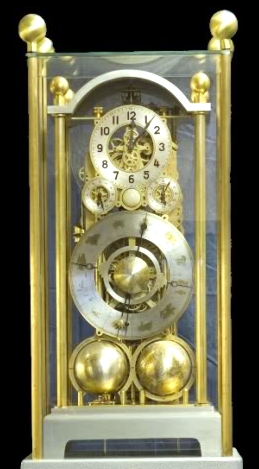Clock No. 3
 Rasmus Sørnes kept improving his design and adding even more features, and in 1954, the 3rd clock was finished.
Rasmus Sørnes kept improving his design and adding even more features, and in 1954, the 3rd clock was finished.
The gear trains from the two previous clocks have been revised for improved accuracy, several correction works have been added to make up for irregularities in the celestial orbits, and most importantly, the precession of the equinoxes has been taken into account.
Features
- Standard time
- Greenwich Mean Time
- Sidereal time
- Gregorian Calendar
- Metonic cycle
- Solar cycle
- The Indiction
- Julian day number
- Sunrise and sunset time
- Time when the Sun is in the south
- High and low tide
- Moon phase
- Terrestrial globe
- Celestial globe
- Sun spot period
- Solar and lunar eclipse indication
- Orrery with nine planets
- Precession of the equinoxes
Solar and lunar eclipses
The large dial in the middle of the front has a fixed Zodiac and two hands showing the position of the Sun and the Moon on the ecliptic circle. The Sun hand makes one revolution every year, and the Moon hand one revolution every 29.5 day.This dial also shows when and where solar and lunar eclipses occur. The orbit of the Moon has an inclination of 5° with regard to the ecliptic, so solar or lunar eclipses can only occur when the Sun and the Moon are simultaneously located at one of the crossings of the two orbits.
These two crossings rotates once in 18.5 years and are indicated by the hand with the Ω (omega) sign. The three hands will only be at the exact same position every 18.5 years, i e when eclipses occur.
In the center of the dial, a spherical slice of the Earth is located. It rotates counter-clockwise once in a sidereal day, and is used to indicated where the eclipse is visible.
Terrestrial and celestial globe
At the bottom of the clock, two globes are located. The terrestrial globe rotates once per day, and the arc shows the division between day and night.The celestial globe shows the stars as they would appear if projected on a sphere surrounding the Earth. It rotates once in a sidereal day, but it also rotates around a second axis once in 25,800 years because of the precession of the equinoxes. To achieve this, a gear train with a ratio of 1:9,500,000 is required.
This globe is illuminated from inside, and holes are drilled for the larger stars.
The Orrery
On the rear of the clock, an Orrery (planetarium) is located over a disc of glass with the Zodiac engraved. It shows the current position of the nine planets. The further away from the Sun a planet is located, the longer time of orbit it has. Pluto has an orbit time of 248 years (Until 2006, Pluto was considered a planet. Today the Solar System only consists of eight planets).The Moon is also included in the Orrery, with its current position relative the Earth.
Location
This clock is on display at Borgarsyssel Museum, Sarpsborg, Norway. However, during 2013 it is stored away while the building is being renovated.
Source reference
- Tor Sørnes: The clockmaker Rasmus Sørnes, Sarpsborg 2008
- All images in this article are copyright the Sørnes family.